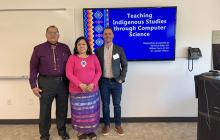Insights on Equity in Computer Science Education
Many students lack access to or don’t participate in high-quality computer science education. This is especially pronounced among girls and students who are Black, Hispanic, multilingual, or economically disadvantaged; live in rural communities; or have disabilities. This puts them at a disadvantage, because computer science is both a fundamental literacy and a rapidly growing, well-paying workforce sector.
In this Q&A, Joseph (“Joey”) Wilson, AIR principal technical assistance consultant and director of AIR’s Center for Evolving Computer Science Education (CS@AIR), shares insights on equitable computer science education.
Q: Why is it important for students to study computer science?
Wilson: Computer science—and artificial intelligence (AI), which is a part of computer science—is not only an academic discipline, but also a fundamental literacy used in nearly every field. It’s embedded across modern society, from using smartphones to connect with others and explore new forms of self-expression to paying for goods and services. At systems and community levels, we use computer science and AI to analyze data that inform decision-making for policies and approaches. Understanding how computer science and AI generate and analyze information is important to ensure that we don’t miss the mark in these contexts.
We also need a diverse group of people who understand how all these technologies work to ensure that we aren’t unintentionally creating inequities or technologies that harm people. There’s a big push to use computer science and artificial intelligence responsibly. That can be hard to do if you don’t have folks with diverse viewpoints and identities building and using computer science and technologies.
Q. What is the role of research in more equitable computer science?
Wilson: The CAPE framework—developed by Carol Fletcher and Jayce Warner at the University of Texas at Austin—is valuable for researchers to think about and study computer science for all: to what extent students have access to it, under what conditions it works, and for whom it works. The framework provides a set of questions to interrogate the quality and inclusiveness of computer science education.
The CAPE Framework
- Capacity is the foundation that supports high-quality computer science education. Policy designs and human and financial resources affect schools’ ability to offer computer science education opportunities, whether in school or out of school.
- Access is about ensuring that all students have equitable access to computer science courses, programs, and opportunities. But only about 57 percent of high schools offer computer science coursework, according to the 2023 State of Computer Science Education report. Access in elementary and middle grades is harder to measure, but there is no doubt that disparities in access exist.
- Participation pushes the idea of ensuring equity and participation. Offering a computer science course or an afterschool club isn’t enough. Some schools take a selective approach to channeling students into courses, which often disadvantages female students, students of color, multilingual learners, and students with disabilities. All students should participate equally, at similar rates.
- Experience helps us understand that there are disparities in computer science course pass rates and who’s getting computer science-related degrees in postsecondary education. The focus here is more on individual students and their outcomes.
CS@AIR has evidence for every level of the CAPE framework. While the framework focuses primarily on ensuring students have equitable access and experiences, AIR extends it as a lens on teachers, who are an integral component to each element of the systems that support computing education. For example, while computer science courses are becoming more prevalent across the country at many levels, many schools still have only one dedicated computer science teacher—if they have one at all. That’s a capacity issue.
Q. What has AIR learned about the effects of access to computer science?
Wilson: The evidence is clear that access, participation, and experience matter. For example, AIR conducted an impact evaluation of Girls Who Code, which aims to close the gender gap in technology with free, virtual summer programs and a supportive community designed to prepare high school students for computer science-related postsecondary education and tech careers. On average, students who participated in these programs were significantly more likely to major in a computer science-related field by at least 10 percentage points. This finding held across diverse student subgroups, including Black/African American students, Hispanic/Latinx students, and students eligible for free and reduced-price lunches.
Access, participation, and experience also matter for the teaching workforce For example, in a study for Teach for America and the University of Oregon, AIR found that aspiring teachers’ interest in teaching computer science was very highly correlated with completion of at least one computer science credit in college. There’s an adage that you can’t be what you can’t see. In this case, I would say you can’t engage in computer science without experiencing it, whether you’re a teacher or a student.
Five or 10 years ago, few postsecondary teacher preparation programs incorporated computer science into teacher training. More are doing so now. While they may call it engineering design or computational thinking, the programs are getting at the idea of thinking about a problem, developing an approach to it, testing it out, collecting data, and refining the approach. We’re also seeing more aspiring teachers who had access to K–12 computing experience, so there is less reluctance to engage with computer science in their teacher preparation programs.
Q. How do researcher-practitioner partnerships support computer science education and research?
Researcher-practitioner partnerships have been a cornerstone in computer science education, due in no small part to the National Science Foundation’s investment in them. This was a recognition that research on pre-K -12 computer science education requires involving practitioners—paraeducators, educators, administrators, and counselors—in the design and development of research for this relatively new topic area.
Researcher-practitioner partnerships are particularly well suited to studying computer science interventions because they provide flexibility to plan, do, study, act, and make revisions if necessary.
As researchers, we must meet teachers where they are and understand the values they hold in their community, what their priorities are, and how we can respond to their needs. Researcher-practitioner partnerships help students gain access, participate, and have really good experiences in computer science, and ultimately decide whether they want to go into a computer science field. Researcher-practitioner partnerships are particularly well suited to studying computer science interventions because they provide flexibility to plan, do, study, act, and make revisions if necessary.
A great example of this is the Wind River Elementary Computer Science Collaborative, a partnership with three tribal school districts and the Wyoming Department of Education. AIR is also a partner and coordinator. While the project began with a different focus, AIR responded to the communities’ desire to revitalize their Eastern Shoshone and Northern Arapaho languages. The new focus is on supporting Indigenous studies through computer science, using MIT Scratch, a coding platform for children that supports storytelling and self-expression.
Q. What’s on the horizon for computer science education?
Wilson: The Computer Science Education Association (CSTA) is kicking off its standards revision process. Many states used these learning objectives, first revised in 2017, and teaching standards to build their state computer science education standards. The field of computer science education looked very different then.
The revision will include artificial intelligence: How do we teach artificial intelligence practices and concepts in ways that are equitable? How do we teach the use of AI and its tools in particular contexts? How do we do that ethically and responsibly? Those questions are very much related to current CSTA practices, like fostering an inclusive computing culture and communicating and collaborating around computing. The standards will influence how AI education within computer science education will play out in the next five to 10 years.


